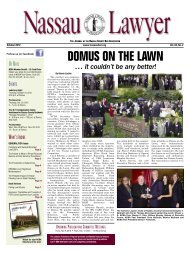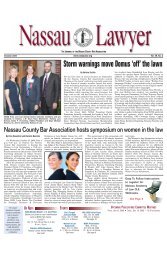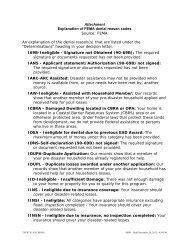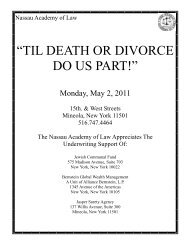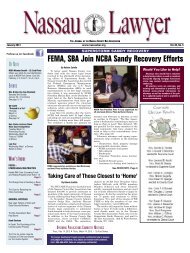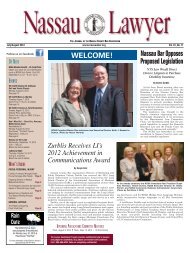302 B.R. 760 Page 4302 B.R. 760(Cite as: 302 B.R. 760)Fed.Rules Civ.Proc.Rule 9(b), 28 U.S.C.A.[24] Fraudulent Conveyances 14186k14 Most Cited CasesBadges <strong>of</strong> fraud, such as court may consider underNew York law in deciding whether transfer wasmade with actual intent to defraud creditors, include:(1) lack or inadequacy <strong>of</strong> consideration; (2) family,friendship or close associate relationship betweenparties; (3) retention <strong>of</strong> possession, benefit or use <strong>of</strong>property in question by debtor; (4) financial condition<strong>of</strong> the party sought to be charged both before andafter transfer; (5) existence or cumulative effect <strong>of</strong>pattern or series <strong>of</strong> transactions, or course <strong>of</strong> conduct,after debt was incurred, financial difficulties began,or creditor suits were initiated or threatened; and (6)general chronology <strong>of</strong> events and transactions underinquiry. N.Y.McKinney's Debtor and Creditor <strong>Law</strong> §276.[25] Fraudulent Conveyances 16186k16 Most Cited CasesUnder New York law, while presence <strong>of</strong> any particularbadge <strong>of</strong> fraud is by no means prerequisite to findingthat transfer was made with actual intent to defraudcreditors, badges <strong>of</strong> fraud appropriately focuscourt's inquiry on circumstances that suggest thatconveyance was made with fraudulent intent, i.e.,with purpose <strong>of</strong> placing debtor's assets out <strong>of</strong> reach <strong>of</strong>creditors.N.Y.McKinney's Debtor and Creditor <strong>Law</strong> § 276.*764 Kramer Levin Naftalis Frankel LLP, New YorkCity, for Debtors.James C. McCarroll, Kramer, Levin, Naftalis &Frankel, LLP, New York City, for Trustee.Bingham McCutchen, New York City, Jonathan B.Alter, Bingham, McCutchen LLP, Hartford, CT, forCreditor Committee.Scott D. Corrigan, Peter Neil Wang, Freidman,Wang & Bleiberg, PC, New York City, for Plaintiff/Appellant.Michael R. Young, Willkie, Farr & Gallagher, LLP,New York City, for Defendant.Kelley Drye, Neil Matthew Merkl, Kelley, Drye &Warren, LLP, New York City, for Appellee.TRAGER, District Judge.Memorandum and OrderPlaintiff-Appellant Sharp International Corp.("Sharp") appeals an order <strong>of</strong> the Bankruptcy Courtfor the Eastern District <strong>of</strong> New York (Craig, J.), dismissingin its entirety an adversary complaint filed bySharp against its former secured lender, State StreetBank and Trust Company ("State Street"). The complaintasserts a claim against State Street under NewYork common law for aiding and abetting Sharp'sthree <strong>of</strong>ficers in breaching their fiduciary duties tothe company. Sharp further claims that a $12 millionpayment Sharp made to State Street in April 1999 insatisfaction <strong>of</strong> a valid antecedent debt is avoidable asa constructive and/or intentional fraudulent conveyancepursuant to New York Debtor & Creditor <strong>Law</strong>(the "D.C.L.") §§ 273-276. Lastly, Sharp asserts thatany claim State Street may subsequently raise byvirtue <strong>of</strong> its return <strong>of</strong> the $12 million payment--ifsuch relief were to be ordered-- should be equitablysubordinated to the claims <strong>of</strong> Sharp's other unsecuredcreditors.Background(1)Sharp is a closely-held New York corporation,which, at all times relevant to this case, was engagedprimarily in the business <strong>of</strong> importing, assemblingand distributing wrist watches, clocks, pens and mechanicalpencils. See Compl. 5, 9. This adversaryproceeding arises out <strong>of</strong> a massive fraud againstSharp and its creditors perpetuated by Sharp's former<strong>of</strong>ficers, Herbert, <strong>Law</strong>rence, and Bernard Spitz (the"Spitzes").In 1993, the Spitzes purchased 100 percent <strong>of</strong>Sharp's common stock. From then until October1999, the Spitzes served as Sharp's sole <strong>of</strong>ficers, withresponsibility *765 over Sharp's day-to-day affairs.[FN1] See id. 10. In January 1995, the Spitzes solda 13 percent ownership interest in Sharp to an outsideinvestor, Bohoradzaner, Inc. Pursuant to agreementsexecuted in connection with this sale, Bohoradzaner,Inc. had "the right to a seat on Sharp's Board <strong>of</strong> Directors,the right to inspect Sharp's books and records,the right to veto certain corporate transactions,and a variety <strong>of</strong> other corporate governance rights."Id. 11. Jaime Bohoradzaner, the principal <strong>of</strong> Bo-© 2009 Thomson Reuters. No Claim to Orig. US Gov. Works.
302 B.R. 760 Page 5302 B.R. 760(Cite as: 302 B.R. 760)horadzaner, Inc., served as a member <strong>of</strong> Sharp'sBoard <strong>of</strong> Directors from January 1995 until October1999. See id. Sharp alleges that "[n]either Bohoradzaner,Inc. nor Mr. Bohoradzaner played anyrole in, or had any knowledge <strong>of</strong>, the fraud and embezzlementcommitted by the Spitzes." Id.FN1. Specifically, Bernard Spitz served asSharp's Chief Executive Officer, HerbertSpitz served as President, and <strong>Law</strong>renceSpitz was Chief Financial Officer. See id. 10.The Spitzes' fraud had two basic components. First,beginning some time prior to 1997 and continuinguntil October 1999, the Spitzes fraudulently inflatedSharp's reported sales and revenues and used thesefalsified financial statements "to raise increasinglylarge sums <strong>of</strong> money from a succession <strong>of</strong> banks andother lenders." [FN2] Id. 15. At the same time, theSpitzes looted Sharp <strong>of</strong> the funds they caused it t<strong>of</strong>raudulently raise, as well as other corporate funds.See id. 16. In 1998 and 1999 alone, the Spitzes stolemore than $44 million from Sharp, diverting thefunds to a variety <strong>of</strong> companies, most <strong>of</strong> which wereowned by or otherwise affiliated with the Spitzes, andwhich provided no consideration to Sharp in exchangefor the transfers. See id.FN2. So great was the scope <strong>of</strong> the fraudthat "[t]he great majority <strong>of</strong> Sharp's reportedaccounts receivable balances during fiscal1997, 1998, and 1999 was comprised <strong>of</strong> fictitioussales," including reported sales to fictitiouscustomers and fictitious sales to actualcustomers. Id. 13. The Spitzes reportedSharp's net sales to be $52.1 millionin 1997 (when its actual sales for that yearwere approximately $24 million), $80.2 millionin 1998 (when actual sales were approximately$21 million), and $118.1 millionin 1999 (when actual sales were approximately$19 million). See id. 14.State Street's relationship with Sharp (and theSpitzes) commenced in November 1996, when StateStreet approved a $20 million demand line <strong>of</strong> creditto Sharp--secured by Sharp's assets--to refinanceSharp's then-current debt with LaSalle Bank and tosupport Sharp's operations. See id. 17. The terms <strong>of</strong>State Street's loan to Sharp were formalized in aCredit Agreement and a Security Agreement, both <strong>of</strong>which were dated December 12, 1996. See id. 18.The $20 million credit limit notwithstanding, StateStreet permitted Sharp's indebtedness to rise to approximately$26 million in 1997. See id. 19. In July1998, the Spitzes raised $17.5 million through theissuance <strong>of</strong> subordinated notes to a group <strong>of</strong> investors(the "Noteholders"). See id. 15. Sharp subsequentlyused a portion <strong>of</strong> the July 1998 proceeds to pay downthe debt to State Street. Thus, by the fall <strong>of</strong> 1998, theState Street debt had been reduced to $15 million.See id. 19.Sharp alleges that State Street began to suspect thepossibility <strong>of</strong> the Spitzes' fraud some time during thesummer <strong>of</strong> 1998, when Sharp breached its loanagreement in numerous respects. In particular,Sharp failed and refused to provide State Streetwith borrowing base reports, detailed accounts receivableaged trial balances, and other documentation,as required by the Credit and Security Agreements,despite State Street's constant *766 requestsfor such information; Sharp failed and refused toimplement an accounting system that would generatemonthly financial statements, despite Sharp'sprior agreement to do so; and Sharp refused to utilizethe State Street lockbox account, throughwhich, pursuant to the parties' Agreements, Sharp'saccount receivables were required to flow.Id. 31. Moreover, based on the documentation thatSharp did furnish, State Street grew concerned thatSharp was growing at an "alarmingly rapid pace" andwas consuming a large amount <strong>of</strong> cash. Id. 32.Sharp contends that State Street's sensitivity to thiskind <strong>of</strong> behavior was "heightened" as a result <strong>of</strong> afraud it had discovered at another <strong>of</strong> its borrowers,PT Imports, with whom State Street developed alending relationship in 1993. See id. 21, 28. Duringthe summer <strong>of</strong> 1998, State Street determined thatPT Imports had "created fictitious accounts receivableand customers, had created fictitious purchaserecords, and had falsely identified vendors who didnot exist." Id. 25. State Street concluded this fraud"had directly caused it to lend large amounts <strong>of</strong>money to PT Imports." Id. Accordingly, in June1998, State Street commenced an action against PTImports in New York State court, seeking damages inexcess <strong>of</strong> $19 million. See id. 26. Like the loan toSharp, the PT Imports loan was made for the purpose<strong>of</strong> refinancing a debt to LaSalle Bank. See id. 17,© 2009 Thomson Reuters. No Claim to Orig. US Gov. Works.
- Page 1 and 2:
Nassau Academy of LawCLE Live Class
- Page 3 and 4: McKinney's Debtor and Creditor Law
- Page 5 and 6: McKinney's Debtor and Creditor Law
- Page 7 and 8: McKinney's Debtor and Creditor Law
- Page 9 and 10: McKinney's Debtor and Creditor Law
- Page 11 and 12: McKinney's Debtor and Creditor Law
- Page 13 and 14: McKinney's Debtor and Creditor Law
- Page 15 and 16: McKinney's Debtor and Creditor Law
- Page 17 and 18: McKinney's Debtor and Creditor Law
- Page 19 and 20: BAKER & HOSTETLER LLP45 Rockefeller
- Page 21 and 22: usiness of defendant Bernard L. Mad
- Page 23 and 24: BACKGROUND, THE TRUSTEE, AND STANDI
- Page 25 and 26: Madoff who received fraudulent tran
- Page 27 and 28: ased on fictitious profits and for
- Page 29 and 30: 28. BLMIS funds were also used to p
- Page 31 and 32: Madoff, and her niece, Shana Madoff
- Page 33 and 34: 42. Ruth Madoff was never an employ
- Page 35 and 36: FIRST CAUSE OF ACTIONTURNOVER AND A
- Page 37 and 38: 66. At the time of each of the Two-
- Page 39 and 40: Transfers; (b) directing that the S
- Page 41 and 42: EIGHTH CAUSE OF ACTIONUNDISCOVERED
- Page 43 and 44: TENTH CAUSE OF ACTIONDISALLOWANCE O
- Page 45 and 46: 111. Mrs. Madoff benefited from the
- Page 47 and 48: WHEREFORE, the Trustee respectfully
- Page 49 and 50: 2(c)(3): (a) preserving the Subsequ
- Page 51 and 52: 302 B.R. 760 Page 1302 B.R. 760(Cit
- Page 53: 302 B.R. 760 Page 3302 B.R. 760(Cit
- Page 57 and 58: 302 B.R. 760 Page 7302 B.R. 760(Cit
- Page 59 and 60: 302 B.R. 760 Page 9302 B.R. 760(Cit
- Page 61 and 62: 302 B.R. 760 Page 11302 B.R. 760(Ci
- Page 63 and 64: 302 B.R. 760 Page 13302 B.R. 760(Ci
- Page 65 and 66: 302 B.R. 760 Page 15302 B.R. 760(Ci
- Page 67 and 68: 302 B.R. 760 Page 17302 B.R. 760(Ci
- Page 69 and 70: 302 B.R. 760 Page 19302 B.R. 760(Ci
- Page 71 and 72: 394 B.R. 721 Page 1394 B.R. 721, 50
- Page 73 and 74: 394 B.R. 721 Page 3394 B.R. 721, 50
- Page 75 and 76: 394 B.R. 721 Page 5394 B.R. 721, 50
- Page 77 and 78: 394 B.R. 721 Page 7394 B.R. 721, 50
- Page 79 and 80: 394 B.R. 721 Page 9394 B.R. 721, 50
- Page 81 and 82: 394 B.R. 721 Page 11394 B.R. 721, 5
- Page 83 and 84: 394 B.R. 721 Page 13394 B.R. 721, 5
- Page 85 and 86: 394 B.R. 721 Page 15394 B.R. 721, 5
- Page 87 and 88: 394 B.R. 721 Page 17394 B.R. 721, 5
- Page 89 and 90: 394 B.R. 721 Page 19394 B.R. 721, 5
- Page 91 and 92: 394 B.R. 721 Page 21394 B.R. 721, 5
- Page 93 and 94: 397 B.R. 642 Page 2397 B.R. 642(Cit
- Page 95 and 96: 397 B.R. 642 Page 4397 B.R. 642(Cit
- Page 97 and 98: 397 B.R. 642 Page 6397 B.R. 642(Cit
- Page 99 and 100: 397 B.R. 642 Page 8397 B.R. 642(Cit
- Page 101 and 102: 397 B.R. 642 Page 10397 B.R. 642(Ci
- Page 103 and 104: 397 B.R. 642 Page 12397 B.R. 642(Ci
- Page 105 and 106:
397 B.R. 642 Page 14397 B.R. 642(Ci
- Page 107 and 108:
443 F.3d 180 Page 2443 F.3d 180(Cit
- Page 109 and 110:
443 F.3d 180 Page 4443 F.3d 180(Cit
- Page 111 and 112:
443 F.3d 180 Page 6443 F.3d 180(Cit
- Page 113 and 114:
443 F.3d 180 Page 8443 F.3d 180(Cit
- Page 115 and 116:
443 F.3d 180 Page 10443 F.3d 180(Ci
- Page 117 and 118:
443 F.3d 180 Page 12443 F.3d 180(Ci
- Page 119 and 120:
Page 2257 A.D.2d 526, 684 N.Y.S.2d
- Page 121 and 122:
Page 4257 A.D.2d 526, 684 N.Y.S.2d
- Page 123 and 124:
Page 6257 A.D.2d 526, 684 N.Y.S.2d
- Page 125 and 126:
770 N.Y.S.2d 421 Page 22 A.D.3d 780
- Page 127 and 128:
Page 14 A.D.3d 495, 773 N.Y.S.2d 71
- Page 129:
Page 34 A.D.3d 495, 773 N.Y.S.2d 71
- Page 132 and 133:
780 N.Y.S.2d 409 Page 29 A.D.3d 553
- Page 134 and 135:
Page 134 A.D.3d 231, 824 N.Y.S.2d 3
- Page 136 and 137:
Page 334 A.D.3d 231, 824 N.Y.S.2d 3
- Page 138 and 139:
Page 2991 F.2d 31(Cite as: 991 F.2d
- Page 140 and 141:
Page 4991 F.2d 31(Cite as: 991 F.2d
- Page 142 and 143:
Page 6991 F.2d 31(Cite as: 991 F.2d
- Page 144 and 145:
FRAUDULENT TRANFERENCESRonald M. Te
- Page 146 and 147:
Nursing home case_ Transfer of pers
- Page 148 and 149:
Sections 548 and 544 work in concer
- Page 150 and 151:
U.S. Supreme CourtBFP v. Resolution
- Page 152 and 153:
example, from net 15 to COD; or cha
- Page 154 and 155:
Bankruptcy Code Section§ 548. Frau
- Page 156:
Ron Terenzi is a founding partner a



